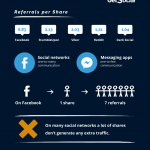Capturing dark social activity can help brands avoid data commodification
Don’t ignore the data on activity that happens outside of regular social channels. Contributor Chuck Moran explains how using dark social will set your data strategy apart from the competition’s.

The signs of programmatic maturity are everywhere, no longer just in aggregate spend figures. We see it as more and more brands buy into the full-stack reality and explore solutions that connect martech to ad tech and data to creative.
At the same time, there are talented people within brands and agencies who have mastered the new digital toolset and become fairly sophisticated about how those tools are used. There’s even what you might call a “programmatic workforce,” marketers with five-plus years of direct experience with the technology who are rising through the ranks. This all paints a picture of relative maturity.
But there’s one major downside to the maturation of programmatic, and it’s causing growing concern among marketers. In short, it’s that the marketplace for third-party data has become increasingly commodified and flattened. Third-party data is losing its efficacy because everybody is using the same stuff, and there’s nothing differentiated about it.
Now that programmatic targeting is table stakes, just having the capacity to execute a data-driven buy no longer provides an edge. Brands are finding that they need to dig deeper, segment better and target more efficiently.
Smart money is betting on first-party data as the answer to the problem of differentiation. Onboarding CRM (customer relationship management) data to match with third-party segments extends the market intelligence of the prepackaged audience segment into the brand’s own unique environment. This approach adds tons of value, but it’s best suited to retention and retargeting. For marketers focused on acquisition and reach, more is required to set the strategy apart from the competition’s.
For real differentiation, brands need to expand beyond CRM data to bring in all of the data that reflects the actions occurring within a brand’s ecosystem. The key may reside in “dark social.”
The power of ‘dark social’
With brands distributing content through email links, social platforms and influencer engagements, the extended reach of a brand’s content becomes difficult to represent in one place. A consumer’s entire engagement experience with the brand extends beyond the footprint of owned properties into the platforms and pathways through which people share the brand’s content.
Whereas in the past, publishers acted as the primary distribution points for brand content (whether in the form of branded content or traditional advertising), today, the consumers themselves act as distributors to their peers. And that sharing happens well beyond the trackable environments of Facebook and Twitter — email, text messages and IM, for example.
The trouble is that the proliferation of social and messaging platforms has radically expanded that ecosystem to the point where a large portion of those actions take place in what is ominously titled the “dark social.”
This dark social realm of second- and third-degree shares is “dark” because the consumer’s touch points with the brand take place beyond the average marketing toolset’s ability to detect and measure reach, and beyond that which is conveyed by the social platforms themselves.
That’s why it is essential for brands today to consider investing in tools that can peer into the dark social and measure branded content’s distribution — and to allow that data to be activated within the ad tech stack.
Activating dark social data within the ad tech stack radically amplifies the power of a brand’s first-party data assets and can set the brand’s programmatic playbook well beyond the reach of what can be bought and sold on the commodified data marketplace.
With the proper mechanisms in place to capture dark social activity, brands and publications can increase their audience well beyond what they had originally estimated.
Effective and efficient, if done right
Using dark social to amplify and extend third-party audience data will not only improve the effectiveness of the campaign, but also its efficiency. Chiefly, this happens in the form of money saved by not spending it on increasingly costly third-party audiences.
The key to realizing such efficiencies, however, is working with the right partners who can bring in the power of dark social capture without a ton of added fuss.
After all, while audience data costs money on the open marketplace, there are also real costs that come with building the infrastructure that maintains the integrity of that data and which positions it for deployment and activation.
The infrastructure needed to understand and manipulate the data is often more expensive than the data itself, and that’s true whether we’re talking here about human resources, artificial intelligence or both.
That’s why it makes sense to conquer the problem of data differentiation and dark social capture through thoughtful strategic partnerships before you bring it in-house — realizing the cost savings up front while mastering the process.
Some opinions expressed in this article may be those of a guest author and not necessarily Marketing Land. Staff authors are listed here.
Marketing Land – Internet Marketing News, Strategies & Tips
(61)






